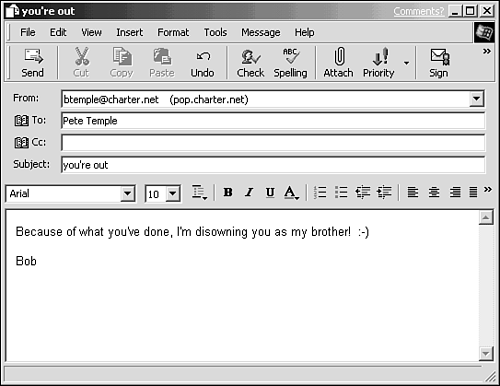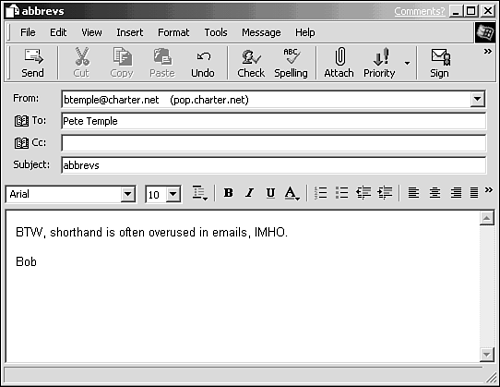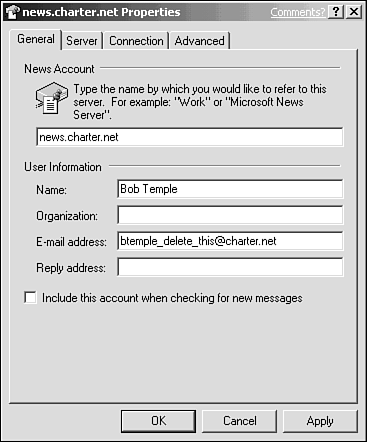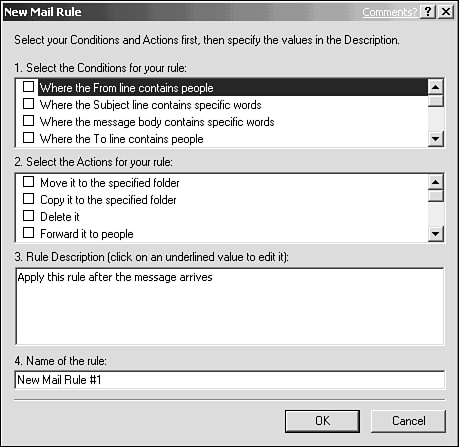| Internet communication is very simple to understand and to use. But a few key mistakes can cause you lots of trouble ”that is, if you're not careful. A different form of etiquette is followed on the Internet. It's called netiquette , and if you don't understand the basic principles of it, you run the risk of offending people, or worse . And, after you've opened yourself up to Internet communication, the chances that you'll receive unwanted mail are pretty good. Just like all those credit card solicitations you get in your mailbox at home, the Internet can fill up your email box pretty quickly with unwanted offers for this or that. Observing Proper Netiquette How you communicate with private friends in email is between you and your friends . But after you begin contributing to discussion groups ”mailing lists and newsgroups ”you're participating in a public forum, and have an obligation to follow a code of conduct that keeps the conversation pleasant and productive for all.  Netiquette is the unofficial online code of conduct. It boils down to the Golden Rule: Do unto others. As you gain experience, you'll begin to notice things others do that bug you, such as quoting too much or writing sloppily. Obviously, those are the things you must remember not to do yourself. | Here are the basics of being a good cyber-citizen, particularly in discussion groups. Note that none of this stuff is law; if you skip a rule, the cyber-police will not show up at your door. (Although there are a few strictly managed lists that will kick you out if you break certain rules ”another reason to read and follow the Welcome message!) Like all forms of courtesy , netiquette is often not strictly required, but always highly recommended. -
Don't shout ” SOME FOLKS LIKE TO TYPE ALL MESSAGES ONLY IN CAPITAL LETTERS, and some others overuse capital letters FOR EMPHASIS! On the Internet, capitalizing letters means you are SHOUTING. Capitalize like you would in a typed letter, and use your word choices and phrasing for emphasis, saving the all-caps trick for rare, EXTREME EMPHASIS. -
Stay on topic ” Nothing is more aggravating than subscribing to a list and then receiving all sorts of messages that veer off on tangents. If your message does not pertain directly to the discussion group 's stated topic, don't send it. -
Keep current ” Newcomers to a list or group, or folks who only drop in occasionally, tend to ask questions that have already been asked and answered a dozen times, which annoys the regulars. Keep up with the conversation so you know what's going on. Read the FAQ, if one is available.  A FAQ is a Frequently Asked Questions file that contains a general list of common questions and answers pertaining to a particular list, newsgroup, Web page, or other topic. | By reading FAQs (pronounced "faks" so that computer book authors can make stupid puns with "fax"), you can quickly bring yourself up to speed on the background information shared by others in the group. When a FAQ is available for a mailing list, you'll find instructions for obtaining the FAQ in the Welcome message.  | -
Don't use sarcastic language ” It's very difficult to communicate sarcasm effectively in a written message. Often, exaggerated messages intended as sarcasm are taken literally by those who read them, and confusion or arguments ensue. -
Keep personal discussions personal ” Before sending any message, ask yourself, "Would this message interest the whole list, or is it really a personal message to just one member?" If the message is really for one person, you can find that person's email address in the header information quoted in all list and newsgroup messages, and send your comment or question directly to that person, in private.  Avoid small, conversational contributions that add little information. For example, if someone posts a message with a great idea in it, don't send a reply to the group just to say "Great idea!" No one wants to go to the trouble of receiving and opening a message with so little to say. | -
Don't over-quote ” When replying, cut quotes down to just what's necessary to show what you're replying to. When a series of replies builds up and nobody cuts the quotes, each message can be pages long even if it contains only one new sentence . Try to leave enough information so that a newcomer to the conversation can tell what's being discussed, but cut everything else. -
Write and spell well ” In the name of speed and efficiency, some folks boil their msg.s down to a grp. of abbrev.'s &/or shorthnd, or write toooo quikly and slopppilly. Do your readers the courtesy of writing whole words and complete sentences, and fix mistakes before you send. -
Neither flame nor counter-flame ” A flame is an angry tirade or attack in a message, the kind that flares when a debate grows into a spat. No matter how hot the argument gets, try to keep your cool. When flamed personally , don't rise to the bait: Flame wars only escalate, and no one ever wins. Some folks flame others for breaches of netiquette, but that's hypocritical. Take responsibility for your own online behavior, and let others worry about theirs. -
Fit in ” Usually, I'm no fan of conformity . But every mailing list and newsgroup has its own, insular culture. After reading messages for a while, you'll pick up a sense of the general technical level of the group, whether they're experts or novices (or both) on the topic at hand, the overall tone, catch phrases, vocabulary, and so on. By all means, be yourself ”any group needs fresh ideas, new personalities. But try to be yourself within the style and culture of the group, to ensure that you can be understood by all. | Adding Personality with Smileys and Shorthand Over the years , a system of symbols and shorthand has developed to enable folks to be more expressive in their messages: Smileys and shorthand . You'll see both used online often, in discussion groups and in email.  Although I show you smileys and shorthand next , I'm doing so mainly to help you understand them in messages you receive. Except for the occasional , simple smiley face, I don't recommend using these in your contributions to discussion groups. There are many newcomers online today who don't know smileys or shorthand, so if you use these, many of your readers won't understand you. Try to put all your meaning in your words, so everybody gets the message. | Smileys Smileys are used to communicate the tone of a message, to add an emotional inflection . (In fact, smileys are sometimes called emoticons ”emotional icons.) They're little pictures, usually of faces, that are built out of text characters . To see the picture, you tilt your head to the left. For example, tilt your head to the left (or tilt this book to the right) while looking at the smiley below, which is made up of three characters: a colon , a dash, and a close parenthesis: :-) Looks like a little smiling face, doesn't it? Folks follow a statement with this smiley to indicate that the statement is a joke, or is made facetiously (see Figure 7.11). Figure 7.11. Using emoticons allows you to add a little personality to your messages.  There are many different smileys, some so obscure that only the real Net jocks use or understand them. But you're likely only to see the basics, including the basic smile shown earlier and also | :-( | Frown | | ;-) | Wink | | :-0 | Surprise | | 8-) | Smile with glasses or bug-eyed | | :'-( | Crying | | :-D | Laughing |  Some folks omit the nose from their smileys; for example: :) ;) :0 | Shorthand Shorthand abbreviations are used to carry a common phrase efficiently , to save space and typing. Some of these are commonly used offline, every day, such as ASAP (as soon as possible). Another shorthand expression used commonly online is IMO (in my opinion) and its cousin, IMHO (in my humble opinion). Figure 7.12 shows an example. Figure 7.12. Shorthand allows you to communicate more succinctly.  Other popular shorthand expressions include the following: BTW ” By the way B4 ” Before FWIW ” For what it's worth IBTD ” I beg to differ IOW ” In other words LOL ” Laughing out loud ( generally used to declare that a statement is laughable) OTOH ” On the other hand ROTFL ” Rolling on the floor laughing (generally used to declare that a statement is extremely laughable) Stopping Junk Email (Spam) Within a few weeks after you begin using the Internet, you'll make an unpleasant discovery: The same sort of take-no- prisoners direct marketing types who telemarket you at suppertime and stuff offers in your mailbox have found you online. Over time, you'll see an ever-increasing number of ads, offers, chain letters, pyramid schemes, and other such scams in your Inbox. This mountain of unwanted crapola is collectively known as spam .  Spam is unsolicited email sent out to a large group of strangers for purposes of advertising products and services, promoting political causes, or making mischief. (Senders of spam are called spammers .) The name might derive from the fact that the messages multiply the way the word "spam" does in an old Monty Python skit, but the term 's origin is unconfirmed. | It's easy and cheap for an advertiser to automatically crank out an email ad to thousands ”millions, even ”of Internet users all at once. These messages often have subject lines designed to entice you into reading the message (FREE $$$) or to trick you into doing so (MESSAGE FROM AN OLD FRIEND). As the Internet population has grown, so has the spam problem. The next few pages offer advice for dealing with the spam problem.  I should say right up front that nothing today can prevent or eliminate spam altogether ”the problem is too pervasive. But by following the advice in this chapter, you can reduce spam to a tolerable amount. Until and unless it's outlawed, spam will remain as sure a fact of life as death, taxes, and telemarketing. | How They Get You The more widely known your email address is, the more spam you'll get ”it's that simple. So a logical first step in stopping spam is being very careful about how and when you reveal your email address. Unfortunately, you cannot fully enjoy the Internet while keeping your email address a secret. Many online activities, such as shopping or posting to newsgroups, create an online record of your email address. In fact, anytime you send email, an unscrupulous spammer might harvest your address by intercepting messages on their way across the Net. Still, you can effectively reduce the extent to which your address is known by making some smart surfing choices. In particular, be careful about    | -
Forms ” Be very careful how and when you fill out online forms or surveys. A growing number of Web sites request that you complete a form to "register" in order to use the site; the form data is almost always used for marketing, and often for spam. On any site where you might complete a form, look for a link to a privacy policy; some Web sites promise in that policy not to spam you or to sell your information to spammers.  Some folks use a secondary email address ”such as a Web-based email address ”on all forms and other activities that are not part of their personal communications. That way, any spam resulting from filling in forms goes to the secondary address, where it's easier to ignore. You still need to check messages on the secondary address from time to time, in case you do get a legitimate message there, and to clean out old messages. But at least you can minimize the day-to-day spam intrusion. | -
Newsgroup postings ” When you post to a newsgroup, a spammer can easily learn two things about you: your email address, and that you're interested in the newsgroup's topic. That's valuable direct marketing information; if you post a message to a newsgroup about a particular kind of product, you can expect to receive spam trying to sell you such a product. If you post to a sex-related newsgroup, you will soon receive spam selling phone sex or other sex- related stuff. You can read newsgroup messages anonymously ”but when you post, you reveal your address. So watch where you post.  Again, all the suggestions offered here are ways to reduce spam ”nothing yet can truly eliminate it. So even if you never visit a sex-related newsgroup and never, ever post to one, you probably will receive spam from sex-related advertisers from time to time. It's not your fault; receiving such messages does not necessarily mean that you did something to bring it on yourself. It's just that the merchants of sex and the merchants of get-rich-quick schemes are the two most aggressive kinds of spammers, and they spam anyone ”and everyone ”they can find. | -
Cookies ” Cookies are files on your computer stored there by a Web site, such as an online store, to record information about you that the page can access next time you visit. Unfortunately, the cookies on your computer ”which might contain your email address and other personal data ”might be read not only by the servers that put them there, but by other servers you visit, who might use that information for spam. -
Mailing lists ” When you subscribe to mailing lists, your name, email address (and your interest in the list's topic) are recorded in a database that might be accessed and copied very easily by a spammer, particularly if the list is managed by an automated program. (Some mailing lists let you keep your address private; read the list's Welcome message for information about a CONCEAL command.) A newsgroup covering the same topic is a safer choice, as long as you don't post to it. If you contribute to the discussion, the mailing list is still less spam-risky than the newsgroup.  Stopping spam is a little trickier for users of online services than for users of ISPs. The online services derive some of their revenue from advertisers, for providing access to you. So they're not too keen on letting you block those ads. Experts on AOL and spam advise users to avoid posting messages on AOL's forums, and to use Internet newsgroups instead. Despite the spam exposure risk in newsgroups, AOL's forums are notoriously harvested by spammers. | | Report 'Em! The people who run Internet servers are generally described as system administrators ( sysadmins ) or as system operators ( sysops ). These folks usually hate spam as much as you do, because it dramatically increases the traffic on their servers, taking up room needed for legitimate communications. There are two times you should contact sysops about spam: -
If you do not want to receive spam, always let the sysop of your Internet provider know how you feel. He or she might be able to take steps to minimize (but not eliminate) spam to your account. You can email your sysop by sending a message to the technical support address for your account. -
You can report spammers to the sysops of their Internet providers, who might then cancel their accounts or issue a warning. To address the message, take the part of the spammer's email address following the @ symbol, and put system@ or sysop@ or support@ in front of it. For example, if you get spam from jerko@serv.com , address messages to support@serv.com system@serv.com sysop@serv.com reporting that the user named Jerko is sending spam. This technique won't work all the time, because spammers are savvy about hiding their real server names . But it's a start. In Newsgroups, Spoof 'Em! Ultimately, having to restrain yourself from posting to newsgroups can severely hamper your ability to enjoy the Net. Here's a technique that some folks use to post to newsgroups while foiling spammer's efforts to cull their addresses: spoofing .  Spoofing , also known as munging , is the practice of scrambling your return email address in newsgroup postings just enough so that if it's harvested by one of the programs spammers use, the resulting spam will never reach you (it'll be sent to the spoofed address, not your real one). | A properly spoofed email address fools the automated harvesting programs that spammers use, but enables real folks on the group to still send you messages. For example, suppose your address is shirley@aol.com You can use your newsreader's configuration dialog boxes to change the Reply to address to shirleytake_out_this_part@aol.com If you use a signature at the bottom of your messages to identify yourself, change the address there, too. You can even add a note to your signature telling readers of your postings how to decode your address to send you email. The programs spammers use aren't smart enough to decode the address or read the note. To spoof your newsgroup return address in Outlook Express, choose Tools, Accounts from the menu bar. On the dialog box that appears, click the News tab, and then click Properties. In the box labeled Email Address, type the spoofed address (see Figure 7.13). Figure 7.13. Use this dialog box in Outlook Express to spoof your return address on newsgroup postings.   Spoofing your newsgroup return address in Netscape Mail is not recommended, because doing so also spoofs your return address on your email messages. That makes it difficult for people to make legitimate replies to your email messages. At the time of this writing, spoofing works pretty well. But inevitably, spammers will smarten up their harvesting programs so that they recognize and decode spoofed addresses. Spoofing is only one step in reducing spam; you still need to do the other stuff described here, too. | Never Reply! Never! Never! Many spam include "removal" instructions, telling you that if you reply to the message and include the words "REMOVE ME" or a similar phrase in the subject line, you'll receive no further messages. In some cases, doing so might work. But in many cases, the "REMOVE ME" bit is actually a trick intended to make you verify your email address, so that the spammer knows he has a live one. In such cases, following the removal instructions won't remove you from the spammer's list, and might even increase the amount of spam you get. Some folks also try to stop spam by sending angry replies to spammers. This approach never works. Often, the "From" line in the spam is left empty, or filled with a dummy or spoofed email address, so a reply won't even reach the real spammer. When angry replies do reach spammers, spammers ignore them. (They know full well that they are bothering some folks. They don't care. If they must annoy a million people in order to make a sale or two or three, they're happy with that.) The moral? Never do anything an unsolicited email tells you to do, even if the instruction claims to be for your benefit. Never. Filter 'Em Out! If you can't stop the spam from coming, your next best bet is to avoid having to look at it. A variety of programs and techniques filter your incoming email to remove unwanted messages.  Filters are settings in your email program (or a special utility) that automatically delete or move messages under specified circumstances. For example, if there's a person whose messages you never want to read, you can configure a filter so that all messages from that person's email address are deleted automatically upon receipt; you'll get them, but they'll be gone before you ever see them. | Filters cannot completely remove spam. In order to set up filters to delete all spam messages, you'd have to know the address of every spammer. No complete master list of spammers exists (new folks start spamming every day, and slippery spammers change addresses often), but you can pick up lists of many of the worst offenders, and then import or manually copy the lists into your email program so you can create filters to block messages from them. Use the following URLs to learn about and download lists of spammers for filtering: -
The BadMail from Spam List: www.webeasy.com/w2/spam/ -
The Network Abuse Clearinghouse: www.abuse.net/ -
The Blacklist of Internet Advertisers: www-math.uni-paderborn.de/%7Eaxel/BL/#list  You can pick up utilities that combine a filtering system with a spammers database, for fast and easy configuration of anti-spam filters. Check out Spambuster at www.contactplus.com, and Spameater Pro at www.hms.com/spameater.htm. | Finding Filters in Your Email Program Most full-featured email programs have their own built-in filtering systems you can apply to manage incoming mail and, to a limited extent, control spam. If you don't have a list of spammers, or if creating filters for a long list is too difficult, you can deal with spam by creating filters for your legitimate contacts. It works like this: If you have a steady group of people you communicate with regularly, create a filter that automatically stores all messages from those people in a separate folder. When you receive email, all the important messages are automatically stored in the folder, while all of the spam stays in your Inbox, where you can ignore it. (You'll still want to scan your Inbox from time to time to check for legitimate messages from folks you haven't added to your filters.) You can find the filters dialog boxes -
In Messenger by choosing Edit, Message Filters. -
In Outlook Express by choosing Tools, Message Rules.  In Outlook Express, you can choose Tools, Message Rules, Mail to open a dialog box in which you can set up all sorts of rules for how incoming messages are handled (see Figure 7.14). But when all you want to do is prevent certain senders from sending you email, just choose Tools, Message Rules, Blocked Senders List, click Add, and type the address of the person from whom you will no longer accept email. Figure 7.14. Email programs use filters (which Outlook Express, shown here, calls Rules) to automatically deal with certain incoming messages in whatever way you choose.  | The Last Resort: Move When all else fails, if you're still getting too much junk mail, there's one reliable (albeit temporary) solution: Change ISPs, or ask your current ISP to change your email address. When you change your email address, spam directed to your old address can't reach you. (Be sure to inform all your legitimate email partners of your new address, and instruct your old ISP not to forward email to your new address.) If your address has found its way into lots of spam databases, you can get a clean start this way.  Changing your email address is an extreme measure, especially if you have been using your address for important purposes, be it business or otherwise . No matter how diligent you are in informing your contacts about the move, some won't notice and you'll miss others. This action should be reserved for only the most severe circumstances. | Eventually, spammers will find you. But if you start clean with a new address, and then diligently apply the steps you learned in this chapter, you might be able to keep the spammers at bay for a time.  |



